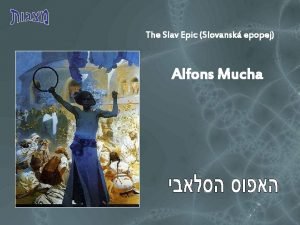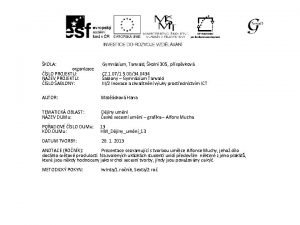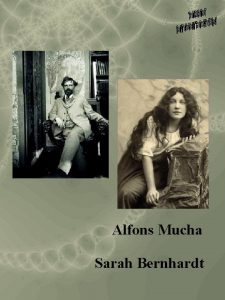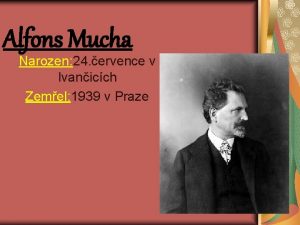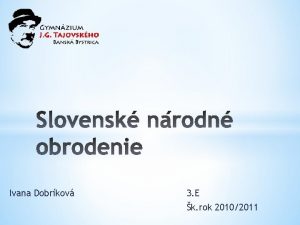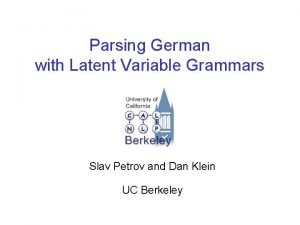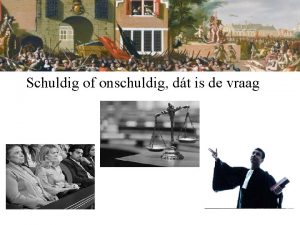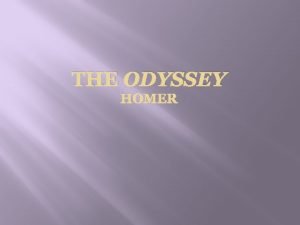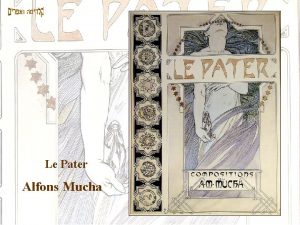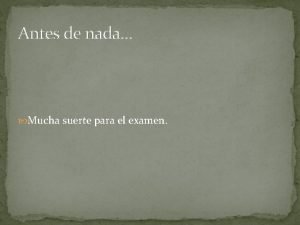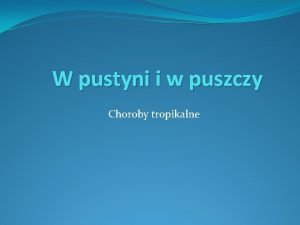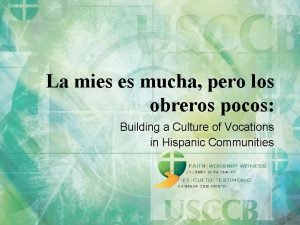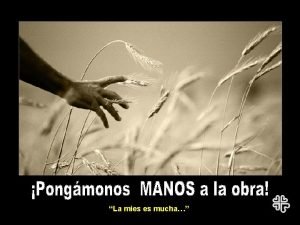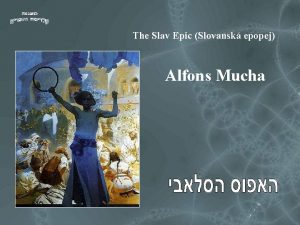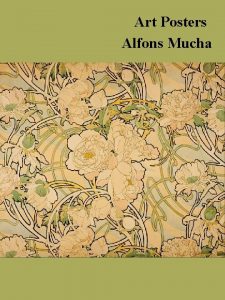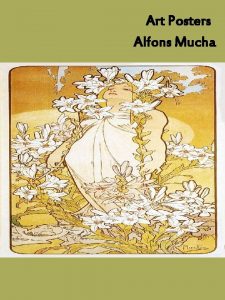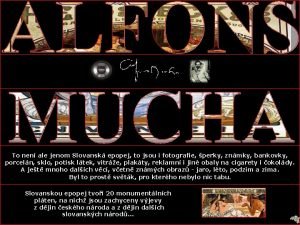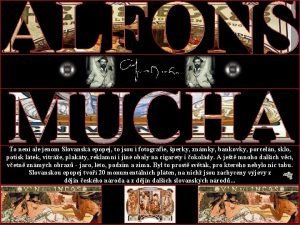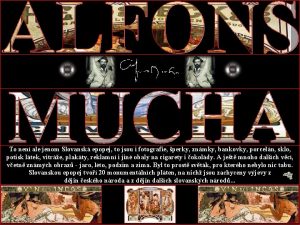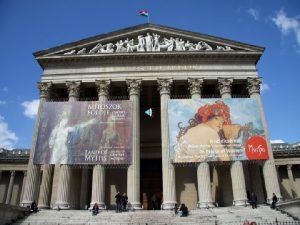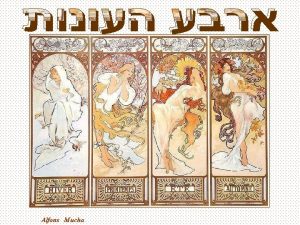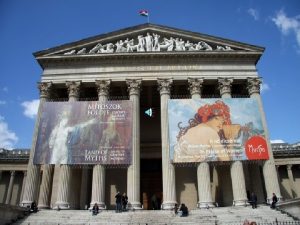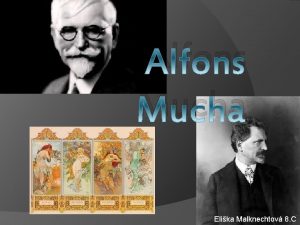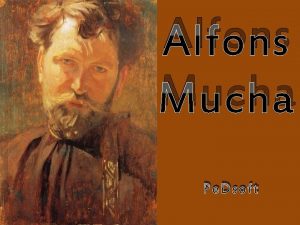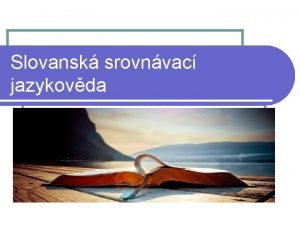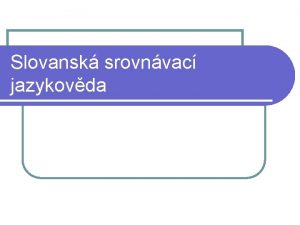The Slav Epic Slovansk epopej Alfons Mucha Slav


































- Slides: 34

The Slav Epic (Slovanská epopej) Alfons Mucha


Slav Epic The Slav Epic is a series of twenty monumental canvases (the largest measuring over 6 by 8 metres) depicting the history of the Slav people and civilisation. Mucha conceived it as a monument for all the Slavonic peoples and he devoted the latter half of his artistic career to the realisation of this work. The idea of the work was formed in 1899, while Mucha was working on the design for the interior of the Pavilion of Bosnia-Herzegovina, which had been commissioned by the Austro-Hungarian government for the Paris Exhibition of 1900. In preparation for the assignment he travelled widely through the Balkans, researching their history and customs as well as observing the lives of the Southern Slavs in the regions that had been annexed by Austria. Hungary two decades earlier. From this experience sprang the inspiration for a new project – the creation of ‘an epic for all the Slavonic peoples’ that would portray the ‘joys and sorrows’ of his own nation and those of all the other Slavs.

Mucha with The Slav Epic canvases exhibited at the Klementium, 1919

Between 1904 and 1909, Mucha visited the United States five times in hopes of finding a benefactor who would support his ambitious project and eventually, on Christmas Day 1909, he secured sponsorship from Charles Richard Crane (1858 -1939), a wealthy Chicago-based businessman and philanthropist. Crane was intensely interested in the development of political affairs in Eastern Europe and Slavonic culture and he was to provide financial and emotional sustenance to Mucha for almost twenty years. Mucha returned to his homeland in 1910 to take up his mission. Between 1911 and 1926 Mucha’s energy was taken up with the creation of the Slav Epic. For this project he rented a studio and an apartment in Zbiroh Castle in Western Bohemia to benefit from the spacious studio enabling him to work on enormous canvases. In the series, he depicted twenty key episodes from the Slavic past, ancient to modern, ten of which depict episodes from Czech history and ten on historical episodes from other Slavonic regions.

The first canvas in the series, The Slavs in Their Original Homeland, was finished in 1912 and the entire series was completed in 1926 with the final canvas, The Apotheosis of the Slavs, which celebrates the triumphant victory of all the Slavs whose homelands in 1918 finally became their very own. With the Slav Epic Mucha wished to unite all the Slavs through their common history and their mutual reverence for peace and learning and eventually to inspire them to work for humanity using their experience and virtue. In 1928, Mucha and Crane officially presented the complete series of the Slav Epic to the City of Prague as a gift to the nation, coinciding with the 10 th Anniversary of its independence

Mucha chose to start history of the Slavic people in the 4 th to 6 th centuries. At this time, the Slavic tribes were agricultural folk who dwelled in the marshes between the Vistula River, the Dnepr River, the Baltic Sea and the Black Sea. With no political structure to support them, their villages were under constant attack by Germanic tribes from the West who would burn their houses and steal their livestock. The couple hiding in the bushes in the foreground as their village burns on the horizon are the survivors of one of these attacks. The fear and vulnerability expressed in their faces beseeches the help of the viewer. A pagan priest flanked by two youths symbolising war and peace floats in the top right of the composition. These figures foretell the peace and freedom that will come to the Slav people when independence is gained through war.

2 -The Celebration of Svantovit, 1912 When Gods Are at War, Salvation is in the Arts, 8, 10 x 6, 10 m


3 -The Introduction of the Slavonic Liturgy, 1912 Praise the Lord in Your Native Tongue, 8, 10 x 6, 10 m

3 -The Introduction of the Slavonic Liturgy German Christian missionaries led a crusade throughout the Moravian Empire in the second half of the 8 th century. In an attempt to prevent the demise of the Slav language, Prince Rostislav engaged two learned monks from Salonika, Cyril and Methodius, to translate the Bible into Old Church Slavonic. This move was opposed by German bishops and Methodius had to travel to Rome to defend the translation. He succeeded in securing Rome’s permission to continue his work and was appointed archbishop of Great Moravia for his efforts. Methodius and Cyril’s translation was instrumental in the survival of the Slavic tongue in subsequent centuries, and they became the Slav people’s most popular saints.

4 -The Bulgarian Tsar Simeon, 1923 The Morning Star of Slavonic Literature, 4, 80 x 4, 05 m

5 -The Bohemian King Přemysl Otakar II, 1924 The Union of Slavic Dynasties, 4, 80 x 4, 05 m

6 -The Coronation of the Serbian Tsar Stefan Dušan as East Roman Emperor, 1926

1916 The Slavonic Epic Poem photographic study

Jan Milíč of Kroměříž, 1916 A Brothel Converted to a Convent 4, 05 x 6, 20 m

8 -Master Jan Hus Preaching at the Bethlehem Chapel- Truth Prevails, 1916, 8, 10 x 6, 10 m


9 -The Meeting at Křížky, 1916, 4. 05 x 6. 20 m Sub utraque

10 -After the Battle of Grunwald, 1924 The Solidarity of the Northern Slavs, 6, 10 x 4, 05 m

11 -After the Battle of Vítkov Hill God Represents Truth, Not Power. 4, 80 x 4, 05 m, 1916

12 -Petr Chelčický at Vodňany Do Not Repay Evil with Evil, 1918, 6, 20 x 4, 05 m

13 -The Hussite King Jiří of Poděbrady - Treaties Are to Be Observed, 1918, 4, 80 x 4, 05 m

14 -Defense of Sziget against the Turks by Nicholas Zrinsky The Shield of Christendom, 1914

15 -The Printing of the Bible of Kralice in Ivančice , 1914 God Gave Us a Gift of Language 8, 10 x 6, 10 m

The Bible of Kralice, also called Kralice Bible was the first complete translation of the Bible from the original languages into the Czech language. Translated by the Unity of the Brethren and printed in the town of Kralice nad Oslavou, the first edition had six volumes and was published between the years 1579 and 1593. The third edition from 1613 is classic and till this day the most widely known and used Czech translation. The New Testament had been translated from the Greek by Jan Blahoslav and published in 1564. Ivančice is a town in the South Moravian Region of the Czech Republic, 21 km south-west of Brno. The town has approximately 9, 300 inhabitants. It lies on the confluence of Oslava, Jihlava and rivers.

16 -The Last days of Jan Amos Komenský in Naarden, 1918 A Flicker of Hope, 6, 20 x 4, 05 m

17 -Holy Mount Athos Sheltering the Oldest Orthodox Literary Treasures, 1926. 4, 80 x 4, 05 m

18 -The Oath of Omladina Under the Slavic Linden Tree, 1926, l 4, 80 x 4, 05 m


'The Slav Epic' cycle No. 20: The Apotheosis of the Slavs, Slavs for Humanity (1926) In the last painting in the series, Mucha sought to bring together all themes addressed in the other 19 episodes of the Slav Epic and celebrate the independence of the Slav nations. The painting is composed of four different parts characterised by four different colours. Each represents a successive period in Slav history: the blue in the bottom right of the painting represents the early years of Slav history; the red in the top right corner signifies the blood shed in the Hussite wars during the Middle Ages; the figures cast in shadow below represent the enemy and the repeated attacks inflicted on Slavic tribes; finally a yellow band in the centre lights up the Czech and Slovak soldiers returning from World War I, signaling the collapse of the Austro-Hungarian Empire and the dawn of a new age for the Slavic people. They are saluted by young boys who wave green branches at them. The bare-chested figure at the centre of the composition is the embodiment of the new, strong and independent republic, guided and protected by a Christ figure behind.

20 -Apotheosis of the Slavs, 1926 Slavs for Humanity, 4, 05 x 4, 80 m


http: //www. muchafoundation. org/gallery/themes/theme/slav-epic http: //poulwebb. blogspot. co. il/2013/04/alphonse-mucha-part-1. html http: //www. settemuse. it/pittori_scultori_europei/alphonse_mucha_opere_2. htm http: //elhurgador. blogspot. co. il/2013/05/manos-la-obra-xxiv-alfons-mucha. html http: //www. pricejb. pwp. blueyonder. co. uk/slav-epic/introduction. htm ואפרים קלריטה : שלנו לאתר להיכנס מוזמנים הנכם www. clarita-efraim. com chefetze@netvision/net. il
 Alfons mucha slav epic
Alfons mucha slav epic Alfons mucha johanka z arku
Alfons mucha johanka z arku Alphonse mucha advertising posters
Alphonse mucha advertising posters Alfons mucha sarah bernhardt posters
Alfons mucha sarah bernhardt posters Slovanská epopej
Slovanská epopej Slovansk
Slovansk Slav petrov
Slav petrov Samos empire
Samos empire Alfons ten brummelhuis
Alfons ten brummelhuis Alfons auer
Alfons auer Alfons beldman
Alfons beldman Dr alfons schmid
Dr alfons schmid Alfons de kameel
Alfons de kameel Homer's first epic poem
Homer's first epic poem Why do epic heroes have supernatural powers
Why do epic heroes have supernatural powers Meňavka včelia
Meňavka včelia Alphonse mucha le pater
Alphonse mucha le pater Pksw
Pksw Actitud racional ejemplos
Actitud racional ejemplos Choroby w pustyni i w puszczy
Choroby w pustyni i w puszczy La mies es mucha y los obreros pocos
La mies es mucha y los obreros pocos Mucho mucha muchos muchas
Mucho mucha muchos muchas Veo que he creado muchos poetas pero no mucha poesía
Veo que he creado muchos poetas pero no mucha poesía La mies es mucha
La mies es mucha Wiersz jana brzechwy wesołe zoo
Wiersz jana brzechwy wesołe zoo Przeobrazenie zupełne
Przeobrazenie zupełne Thế nào là hệ số cao nhất
Thế nào là hệ số cao nhất Hệ hô hấp
Hệ hô hấp Tư thế ngồi viết
Tư thế ngồi viết đặc điểm cơ thể của người tối cổ
đặc điểm cơ thể của người tối cổ Mật thư anh em như thể tay chân
Mật thư anh em như thể tay chân Bổ thể
Bổ thể Chụp tư thế worms-breton
Chụp tư thế worms-breton Tư thế ngồi viết
Tư thế ngồi viết ưu thế lai là gì
ưu thế lai là gì
